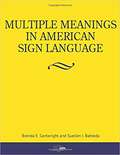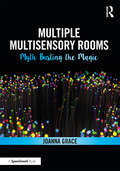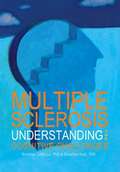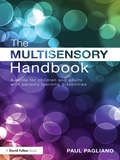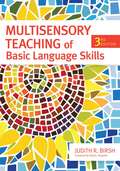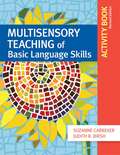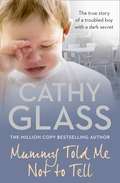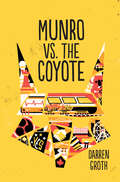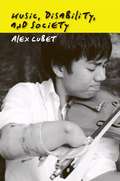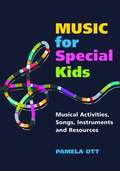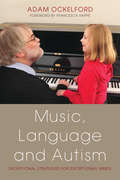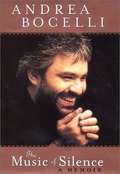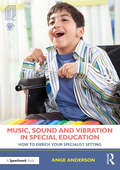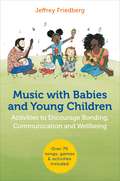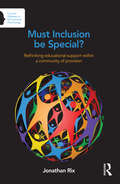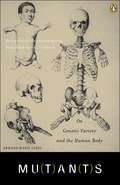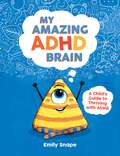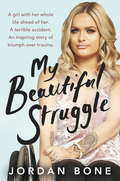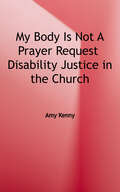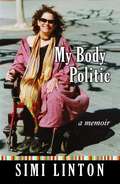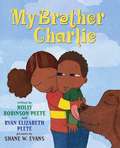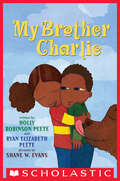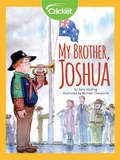- Table View
- List View
Multiple Meanings in American Sign Language
by Brenda E. Cartwright Suellen J. BahledaThere are a variety of ways one can use this book to improve one's signing and interpreting skills. Teachers and students may choose to explore one particular unit or a variety of elements from different units. This book assists in developing and practicing a process for analyzing the meaning of specific English words and phrases so that one can create accurate equivalents in ASL. It is crucial that learners avoid the temptation to hurry through any exercise, even when a word or phrase seems easy or obvious. By taking the time to analyze and determine the meanings of the various words and phrases in the exercises within this book, a process for analyzing meaning emerges which serves as a foundation for analyzing the meaning of English words and phrases and translating this meaning accurately, efficiently and proficiently into ASL.
Multiple Multisensory Rooms: Myth Busting the Magic
by Joanna GraceMultisensory rooms are widely used across the country in schools, care settings, hospitals and homes. Even settings such as football stadiums and airports are installing multisensory environments. Nevertheless, a significant lack of effective research has led to a sense of unease around sensory rooms. This crucial book explores the use of multisensory rooms in order to ease that anxiety; taking the mystery out of multisensory rooms, and supporting the reader to reflect and make the most out of their space. Key features include: Guidance on creating sensory spaces on any budget, to suit any level of need. An overview of the history of multisensory rooms, and a detailed exploration of the actual way in which the rooms are used today. A framework for evaluating existing practices and equipment, in order to maximise the potential of the room. A focus on the practitioner as the most important piece of ‘equipment’ in any sensory room. Written by a leading sensory specialist in a fully accessible way, this book is an invaluable tool for anybody who uses, or is considering using, a multisensory room.
Multiple Sclerosis: Understanding the Cognitive Challenges
by Nicholas Larocca Rosalind KalbWritten by two clinical psychologists with contributions from two neuropsychologists -- each an MS specialist -- Multiple Sclerosis: Understanding the Cognitive Challenges answers all questions patients may have about their condition, including: A definition of cognition and discussion of the processes that underlie human thought The emotional and social impact of cognitive changes The neuropsychological evaluation of cognitive symptoms Detailed overview of treatment options Vignettes describing the real-life experiences of people with cognitive dysfunction Extensive references to the scientific literature Combining detailed, referenced advice with hands-on strategies for living, this is the only book to provide in-depth information about cognitive dysfunction. It will be an invaluable reference to patients, families, and caregivers, as well as to health professionals who care for people with MS.
The Multisensory Handbook: A guide for children and adults with sensory learning disabilities
by Paul PaglianoDo you support a child or adult with sensory perceptual issues or cognitive impairment? For people with challenging sensory and cognitive conditions, everyday life can become so unpredictable and chaotic that over time, lack of engagement can often lead to a state of learned helplessness. In this insightful text, Paul Pagliano shows how ‘learned helplessness’ can be transformed into learned optimism through multisensory stimulation, and explains how a programme of support can be designed and modulated to match the person’s needs, interests and abilities. Full of practical, easy to use multisensory assessment tools and intervention strategies, this book will help: foster a feeling of ease with the environment the child or adult experience pleasure and happiness kick-start their desire to explore encourage improved learning, social well-being and quality of life. The author offers an abundance of exciting multisensory stimulation ideas that can be applied to communication, play, leisure and recreation, therapy and education. Practical resources also show how to monitor and review applications to ensure they are being used in the most effective and enjoyable ways possible. Informed by an astute, up-to-date, comprehensive overview of research and theory, The Multisensory Handbook will appeal to primary professionals from a wide range of disciplines including education, health and social care.
Multisensory Teaching of Basic Language Skills (3rd Edition)
by Judith R. BirschAs new research shows how effective systematic and explicit teaching of language-based skills is for students with learning disabilities—along with the added benefits of multisensory techniques—discover the latest on this popular teaching approach with the third edition of this bestselling textbook. Adopted by colleges and universities across the country, this definitive core text is now fully revised and expanded with cutting-edge research and more on hot topics such as executive function, fluency, and adolescent literacy. The most comprehensive text available on multisensory teaching, this book shows preservice educators how to use specific multisensory approaches to dramatically improve struggling students' language skills and academic outcomes in elementary through high school.
Multisensory Teaching Of Basic Language Skills Activity Book
by Suzanne Carreker Judith R. BirshWith the new edition of this activity book--the companion to Judith Birsh's bestselling text, Multisensory Teaching of Basic Language Skills--students and practitioners will get the practice they need to use multisensory teaching effectively with students who have dyslexia and other learning disabilities. Ideal for both pre-service teacher education courses and in-service professional development, the activity book aligns with the third edition of the Multisensory Teaching textbook, so readers can easily use them in tandem.
Mummy Told Me Not to Tell: The True Story of a Troubled Boy with a Dark Secret
by Cathy GlassReece is the last of six siblings to be fostered. Having been in care for four months his aggressive and disruptive behaviour has seen him passed from carer to carer. Although only 7, he has been excluded from school, and bites people so often that his mother calls him 'Sharky'. Cathy wants to find the answers for Reece's distressing behaviour, but he has been sworn to secrecy by his mother, and will not tell them anything. As the social worker prepares for the final hearing, he finds five different files on Reece's family, and is incredulous that he had not been removed from them as a baby. When the darkest of family secrets is revealed to Cathy, Reece's behaviour suddenly starts to make sense, and together they can begin to rebuild his life.
Munro vs. the Coyote
by Darren GrothSince the sudden death of his younger sister, Evie, sixteen-year-old Munro Maddux has been having flashbacks and anger-management issues. He has a constant ache in his right hand. And there's a taunting, barking, biting voice he calls "the Coyote." Munro knows a six-month student exchange will not be the stuff of teenage dreams, but in Brisbane, he intends to move beyond his troubled past. It is there, at an assisted-living residence called Fair Go Community Village, that Munro discovers the Coyote can be silenced. Munro volunteers as a "Living Partner" and gets to know the team of residents he is assigned to. The burden Munro carries, however, is not so easily cast aside. When one of the team makes the decision to leave, the Coyote gets a new life. When a second resident is taken away, the specter of trauma and death looms larger than ever. Will Munro learn how to silence the voice? Or will the Coyote ultimately triumph?
Murphy's Boy: He Was a Frightened Boy Who Refused to Speak - Until a Teacher's Love Broke Through the Silence
by Torey L. HaydenHe sounded like a lost case right from the beginning. A fifteen year old boy who had not said a word since he was seven. And that wasn't the worst of it. When therapist Torey Hayden accepted this assignment others had long dismissed as futile, she knew she was in for a major challenge. But when she actually confronted Kevin, an institutionalized, retarded boy on the brink of manhood, who hid under tables, who feared highways and door hinges and spirals on notebooks and odd bits of string, who feared water too much to bathe and nakedness too much to change his clothes, she saw that bringing him back would take a miracle. And when the miracle happened, and Torey managed to penetrate Kevin's terrible silence, it was only to discover, lurking beneath a past littered with violence and mental cruelty, a dreadful secret, made all the worse by the bureaucracy that had recorded it, then filed it away.
Music, Disability, and Society
by Alex LubetMusical talent in Western culture is regarded as an extraordinary combination of technical proficiency and interpretative sensitivity. In Music, Disability, and Society, Alex Lubet challenges the rigid view of technical skill and writes about music in relation to disability studies. He addresses the ways in which people with disabilities are denied the opportunity to participate in music. Elaborating on the theory of "social confluence," Lubet provides a variety of encounters between disability and music to observe radical transformations of identity. Considering hand-injured and one-handed pianists; the impairments of jazz luminaries Django Reinhardt, Horace Parlan, and "Little" Jimmy Scott; and the "Blind Orchestra" of Cairo, he shows how the cultural world of classical music contrasts sharply with that of jazz and how musicality itself is regarded a disability in some religious contexts. Music, Disability, and Society also explains how language difference can become a disability for Asian students in American schools of music, limiting their education and careers. Lubet offers pungent criticism of the biases in music education and the music profession, going so far as to say that culture disables some performers by adhering to rigid notions of what a musician must look like, how music must be played, who may play it, and what (if any) is the legitimate place of music in society. In Music, Disability, and Society, he convincingly argues that where music is concerned, disability is a matter of culture, not physical impairment.
The Music of Silence: A Memoir
by Andrea Bocelli Stanislao PuglieseYou don't have to be an opera fan to appreciate this beautifully written memoir by world-famous tenor Andrea Bocelli. Born among the vineyards of Tuscany, Bocelli was still an infant when he developed glaucoma. Music filtering into his room soothed the unsettled child. By the age of twelve he was completely blind, but his passion for music brought light back into his life. Here Bocelli reveals the anguish of his blindness and the transcendent experience of singing. He writes about his loving parents, who nurtured his musical interests, the challenges of learning to read music in Braille and of competing in talent shows, his struggles with law school, and his desire to turn an avocation into a way of life. He describes falling in love and singing in piano bars until his big break in 1992, when a stunned Pavarotti heard him sing "Miserere." The international acclaim and success that have followed Bocelli ever since have done nothing to dull his sense of gratitude and wonder about the world. No classical music fan can afford to be without this engaging and humble memoir of a fascinating and triumphant star. ANDREA BOCELLI wrote this memoir himself on a special Braille computer, without a ghostwriter. He chose to tell his own life story through the eyes of a boy called Amos, a charming and unusual device characteristic of this modest man. Bocelli lives in Monte Carlo and summers in Tuscany.
Music, Sound and Vibration in Special Education: How to Enrich Your Specialist Setting
by Ange AndersonThis book provides practical guidance on how to successfully incorporate music, sound and vibration into your special school, exploring the rich benefits that musical opportunities offer for children with physical, mental health and learning disabilities. Music has been shown to improve mood, lift depression, improve blood flow and even ease pain, whilst musical interventions can encourage communication and enable relaxation. This book explores the physical, cognitive and mental health benefits of music use in special schools, introducing therapies and innovations that can be adapted for use in your own specialist setting. Key features include: • Chapters exploring a range of music therapies and technologies that allow all students to access the benefits of music, sound and vibration, from one-to-one therapeutic music sessions to vibro-acoustic therapy and sing and sign • Case studies and anecdotes showcasing the innovative ways that special schools are using music, and providing concrete examples of how to deliver, record and access music provision • Photocopiable policies, risk assessments and links to useful resources Written by an author with a wealth of experience in special education, this book is essential reading for all those working in specialist settings or with children with SEND.
Music with Babies and Young Children: Activities to Encourage Bonding, Communication and Wellbeing
by Jeffrey FriedbergFrom day one in a child's life, music is one of the most important things that can be used to help them grow and learn. Musical stimulation helps lay the foundations for a lifetime of skills, and this straightforward guide gives detailed advice on how to use music to help children from 0-5 years with common developmental challenges such as attachment and bonding, bedtime, tantrums and daily living skills, social skills, motor skills and school readiness. Combining cutting-edge research on brain development with proven strategies, this book helps with both typical and atypical issues in the earliest stages of a child's life. Friedberg lays out the musical parenting approach, where any adult can enhance children's lives through music. No prior music skill is necessary to use the musical parenting approach, making it an ideal resource for all parents, teachers and professionals to raise healthy, well-adjusted children in a creative and interactive manner.
Must Inclusion be Special?: Rethinking educational support within a community of provision (Current Debates in Educational Psychology)
by Jonathan RixMust Inclusion be Special? examines the discord between special and inclusive education and why this discord can only be resolved when wider inequalities within mainstream education are confronted. It calls for a shift in our approach to provision, from seeing it as a conglomeration of individualised needs to identifying it as a conglomeration of collective needs. The author examines the political, medical and cultural tendency of current times to focus upon the individual and contrasts this with the necessity to focus on context. This book distinguishes the theoretical perspectives that are often associated with special or inclusive education and the broad range of interests which depend upon their ongoing development. This examination leads to a problematisation of mainstream education provision, our understanding of why social inequities emerge and how additional support can overcome these inequities. Further chapters explore the underlying challenges which emerge from our use and understanding of the notions of special and inclusive, outlining an alternative approach based upon a community of provision. This approach recognises the interconnectedness of services and the significance of context, and it encapsulates the aspiration of much international legislation for participation and inclusion for all. But it also assumes that we tend towards diffuse practices, services, policies, settings and roles, spread across provision which is variously inclusive and exclusionary. In seeking to create equitable participation for all, support needs to shift its focus from the individual to this diffuse network of contexts. Must Inclusion be Special? emerges from the research base which problematises inclusion and special education, drawing upon examples from many countries. It also refers to the author’s research into pedagogy, language and policy, and his experiences as a teacher and the parent of a child identified with special educational needs.
Mutants: On Genetic Variety and the Human Body
by Armand Marie LeroiStepping effortlessly from myth to cutting-edge science, Mutants gives a brilliant narrative account of our genetic code and the captivating people whose bodies have revealed it--a French convent girl who found herself changing sex at puberty; children who, echoing Homer's Cyclops, are born with a single eye in the middle of their foreheads; a village of long-lived Croatian dwarves; one family, whose bodies were entirely covered with hair, was kept at the Burmese royal court for four generations and gave Darwin one of his keenest insights into heredity. This elegant, humane, and engaging book "captures what we know of the development of what makes us human" (Nature).
My Amazing ADHD Brain: A Child's Guide to Thriving with ADHD
by Emily SnapePip is a confident little monster who has ADHD. In this book, they share what that means for them and how it has some really brilliant benefits.My Amazing ADHD Brain is packed with reassuring words, practical advice and skill-building activity ideas, and has a fun, relatable voice.
My Beautiful Struggle
by Jordan BoneA girl with her whole life ahead of her. A terrible accident. An inspiring story of triumph over trauma. Aged 15, Jordan was a happy-go-lucky girl; having fun with friends and loving life. In one fateful moment, everything changed. A car accident left her paralysed from the chest down and shocked her into deep depression. She was on the brink of giving up. But gradually Jordan realised there is hope beyond utter devastation, and life beyond disability.Painstakingly re-learning how to apply her beloved make-up, Jordan began to rebuild her sense of self and empowerment. Her body may have been broken but her spirit was not. She is now a successful beauty blogger and her journey of positivity inspires millions around the world.MY BEAUTIFUL STRUGGLE is the incredible true story of how one young woman overcame immense challenges, of inner strength that lies beneath outer beauty, of how to believe in yourself and find the light when it feels like all hope is gone.
My Beautiful Struggle
by Jordan Bone<P>Aged 15, Jordan Bone got into a car with friends. She would never walk again. Paralysed from the chest down, her life was changed forever. Becoming depressed and feeling like life wasn't worth living, these weren't the teenage years that Jordan had envisaged. <P>However, slowly but surely, she began to get herself out of the darkness. With a little help from the internet, Jordan started to embrace positive thinking and embarked on a personal journey to get her confidence - and her life - back. Eleven years on from the accident, Jordan creates her own beauty tutorials on YouTube and has a range of successful brand partnerships. She has reclaimed her life and her independence and now wants to share her inspirational story with others and is telling it through different aspects of beauty. This isn't a book about looking good on the surface, this is a story of inner strength, believing in yourself and finding motivation when you feel like all hope is gone.
My Body Is Not a Prayer Request: Disability Justice in the Church
by Amy KennyWith humorous prose and wry wit, Kenny makes a convincing case for all Christians to do more to meet access needs and embrace disabilities as part of God's kingdom. . . . Inclusivity-minded Christians will cheer the lessons laid out here."--Publishers Weekly. Much of the church has forgotten that we worship a disabled God whose wounds survived resurrection, says Amy Kenny. It is time for the church to start treating disabled people as full members of the body of Christ who have much more to offer than a miraculous cure narrative and to learn from their embodied experiences. Written by a disabled Christian, this book shows that the church is missing out on the prophetic witness and blessing of disability. Kenny reflects on her experiences inside the church to expose unintentional ableism and cast a new vision for Christian communities to engage disability justice. She shows that until we cultivate church spaces where people with disabilities can fully belong, flourish, and lead, we are not valuing the diverse members of the body of Christ. Offering a unique blend of personal storytelling, fresh and compelling writing, biblical exegesis, and practical application, this book invites readers to participate in disability justice and create a more inclusive community in church and parachurch spaces. Engaging content such as reflection questions and top-ten lists are included.
My Body Politic: A Memoir
by Simi Linton"I read My Body Politic with admiration, sometimes for the pain that all but wept on the page, again for sheer exuberant friendships, for self-discovery, political imagination, and pluck. . . . Wonderful! In a dark time, a gift of hope. -Daniel Berrigan, S. J. "The struggles, joys, and political awakening of a firecracker of a narrator. . . . Linton has succeeded in creating a life both rich and enviable. With her crackle, irreverence, and intelligence, it's clear that the author would never be willing to settle. . . . Wholly enjoyable. " -Kirkus Reviews "Linton is a passionate guide to a world many outsiders, and even insiders, find difficult to navigate. . . . In this volume, she recounts her personal odyssey, from flower child . . . to disability-rights/human rights activist. " -Publishers Weekly "Witty, original, and political without being politically correct, introducing us to a cast of funny, brave, remarkable characters (including the professional dancer with one leg) who have changed the way that 'walkies' understand disability. By the time Linton tells you about the first time she was dancing in her wheelchair, you will feel like dancing, too. " ---Carol Tavris, author of Anger: The Misunderstood Emotion "This astonishing book has perfect pitch. It is filled with wit and passion. Linton shows us how she learned to 'absorb disability,' and to pilot a new and interesting body. With verve and wonder, she discovers her body's pleasures, hungers, surprises, hurts, strengths, limits, and uses. " -Rosemarie Garland-Thomson, author of Extraordinary Bodies: Figuring Physical Disability in American Culture and Literature "An extraordinarily readable account of life in the fast lane. . . a brilliant autobiography and a great read. " -Sander L. Gilman, author of Fat Boys: A Slim Book While hitchhiking from Boston to Washington, D. C. , in 1971 to protest the war in Vietnam, Simi Linton was involved in a car accident that paralyzed her legs and took the lives of her young husband and her best friend. Her memoir begins with her struggle to regain physical and emotional strength and to resume her life in the world. Then Linton takes us on the road she traveled (with stops in Berkeley, Paris, Havana) and back to her home in Manhattan, as she learns what it means to be a disabled person in America. Linton eventually completed a Ph. D. , remarried, and began teaching at Hunter College. Along the way she became deeply committed to the disability rights movement and to the people she joined forces with. The stories in My Body Politic are populated with richly drawn portraits of Linton's disabled comrades, people of conviction and lusty exuberance who dance, play-and organize--with passion and commitment. My Body Politic begins in the midst of the turmoil over Vietnam and concludes with a meditation on the U. S. involvement in the current war in Iraq and the war's wounded veterans. While a memoir of the author's gradual political awakening, My Body Politic is filled with adventure, celebration, and rock and roll-Salvador Dali, James Brown, and Jimi Hendrix all make cameo appearances. Linton weaves a tale that shows disability to be an ordinary part of the twists and turns of life and, simultaneously, a unique vantage point on the world.
My Brother Charlie: A Sister's Story of Autism
by Holly Robinson Peete Ryan Elizabeth Peete<P>Callie is very proud of her brother Charlie. He's good at so many things--swimming, playing the piano, running fast. And Charlie has a special way with animals, especially their dog, Harriett. <P>But sometimes Charlie gets very quiet. <P>His words get locked inside him, and he seems far away. Then, when Callie and Charlie start to play, Charlie is back to laughing, holding hands, having fun. Charlie is like any other boy--and he has autism. <P> In this story, told from a sister's point of view, we meet a family whose oldest son teaches them important lessons about togetherness, hope, tolerance, and love.
My Brother Charlie
by Holly Robinson Peete Ryan Elizabeth PeeteFrom bestselling author and actress Holly Robinson Peete--a heartwarming story about a boy who happens to be autistic, based on Holly's son, who has autism."Charlie has autism. His brain works in a special way. It's harder for him to make friends. Or show his true feelings. Or stay safe." But as his big sister tells us, for everything that Charlie can't do well, there are plenty more things that he's good at. He knows the names of all the American presidents. He knows stuff about airplanes. And he can even play the piano better than anyone he knows.Actress and national autism spokesperson Holly Robinson Peete collaborates with her daughter on this book based on Holly's 10-year-old son, who has autism.
My Brother, Joshua
by Nola HoskingAlex wants his brother Josh to play bugle in a patriotic ceremony at a school, but Alex's brother has Down syndrome. Will he be able to?
